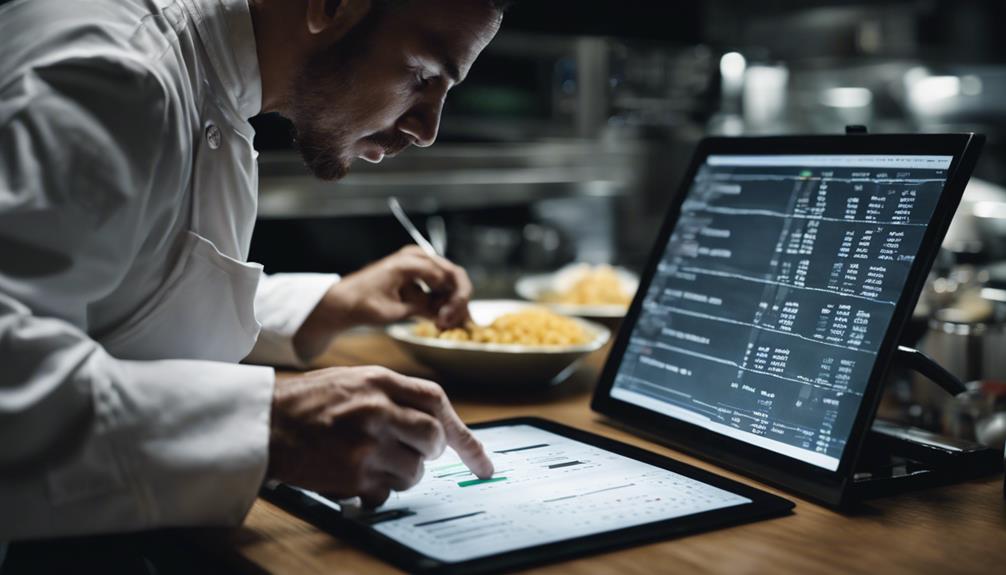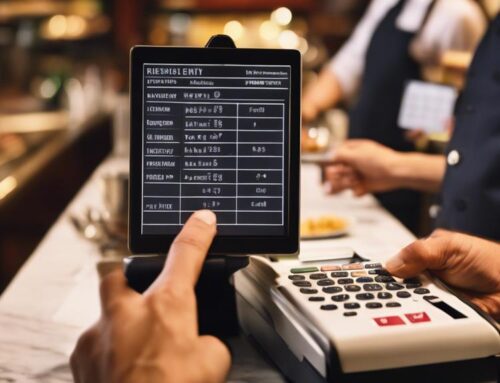In restaurant menu data entry, data analysis plays a crucial role by tracking popular menu items, adjusting pricing strategically, identifying trends, and optimizing menu layout for increased profitability. By analyzing customer preferences and behaviors, you can tailor menu offerings, enhance customer satisfaction, and drive sales. Utilize data-driven insights to innovate menus, place high-profit items strategically, and adapt to changing market trends.
By harnessing the power of data analysis, you can make informed decisions that anticipate evolving customer tastes, ensuring competitiveness, maximizing profitability, and ultimately enhancing your restaurant’s success. Improve your menu strategies and drive customer satisfaction with data analysis in menu data entry.
Tracking Popular Menu Items
To effectively monitor customer preferences, it is essential to track popular menu items using advanced data analysis techniques. Item popularity is a critical aspect of understanding customer behavior and making informed decisions regarding menu offerings. Through menu item analysis, you can identify trends, seasonal variations, and customer favorites that drive sales and customer satisfaction.
By utilizing data analysis tools, you can track the popularity of each menu item over time. This analysis allows you to see which items consistently perform well and which may need adjustment. Understanding item popularity can also help in optimizing inventory management, reducing waste, and increasing profitability.
Menu item analysis provides valuable insights into customer preferences, allowing you to tailor your menu to meet their needs effectively. By tracking popular items, you can make strategic decisions regarding pricing, promotions, and menu changes to enhance the overall dining experience and drive revenue. Incorporating data analysis into your menu planning process is crucial for staying competitive in the ever-evolving restaurant industry.
Adjusting Pricing Strategically
Tracking popular menu items through data analysis can directly influence how you strategically adjust pricing to maximize profitability and customer satisfaction. Pricing analysis plays a crucial role in determining the optimal price points for different menu items. By analyzing data on the popularity of items, customer preferences, and profit margins, you can make informed decisions on adjusting prices to drive revenue while keeping customers satisfied.
Strategic adjustments in pricing can be made based on the insights derived from data analysis. For instance, if a particular dish is extremely popular but has a low-profit margin, you may consider increasing its price slightly to improve profitability. On the other hand, if an item is not selling well despite having a high margin, lowering its price could attract more customers and increase overall sales.
Identifying Menu Trends
Identifying menu trends involves analyzing customer preferences, ordering patterns, and seasonal variations to optimize menu offerings and drive sales. By closely monitoring menu item preferences, restaurants can understand which dishes are popular among customers and adjust their offerings accordingly. Seasonal variations play a crucial role in menu trends as well, influencing ingredients, flavors, and customer preferences throughout the year. This analysis not only helps in catering to changing customer tastes but also in planning for ingredient sourcing and maintaining strong supplier relationships.
Understanding menu trends allows restaurants to stay ahead in a competitive market by offering dishes that align with customer preferences. By incorporating popular ingredients and seasonal variations into menu items, restaurants can attract more customers and increase sales. Additionally, by optimizing menu offerings based on these trends, restaurants can enhance customer satisfaction and loyalty, ultimately leading to business growth and success.
Optimizing Menu Layout for Sales
To optimize your menu layout for increased sales, consider implementing sales-boosting design elements and data-driven layout strategies. By strategically placing high-profit items, using visual hierarchy, and facilitating easy navigation, you can maximize revenue through an optimized menu layout. Leveraging data to understand customer behavior and preferences will guide you in creating a menu layout that drives sales and enhances the overall dining experience.
Sales Boosting Menu Design
Optimize your restaurant menu layout strategically to boost sales and enhance customer engagement. When designing your menu, consider the following tips:
- Strategic Placement: Position high-profit items strategically on the menu to attract attention.
- Menu Customization: Offer customizable options to cater to individual preferences and increase order value.
- Visual Appeal: Use images sparingly but effectively to highlight popular or profitable dishes.
- Clear Pricing: Ensure prices are easy to read and understand, avoiding the use of overly complex pricing structures.
Implementing these menu design strategies can help drive sales and create a more engaging dining experience for your customers.
Data-Driven Layout Strategies
Enhance your menu’s layout for increased sales by leveraging data-driven strategies that focus on customer behavior and preferences. Utilizing data-driven design can optimize your menu layout effectively. Analyzing customer preferences and purchasing patterns allows you to strategically place high-profit items where they are likely to be noticed first.
Consider using heat maps to identify hot spots on your menu where the eyes of customers are drawn, and place profitable items in these prime locations. Furthermore, A/B testing different layouts based on data insights can help determine the most effective design for maximizing sales. By continuously analyzing and adapting your menu layout using data-driven techniques, you can create a visually appealing and strategically optimized menu that drives increased revenue.
Maximizing Revenue Through Layout
Utilize data-driven insights to strategically position high-profit menu items and optimize layout for increased sales. When organizing your menu for revenue optimization, consider the following:
- Highlighting Specials: Place high-profit items or specials in a prominent location on the menu to draw attention.
- Strategic Placement: Position items with higher profit margins in areas where customers’ eyes naturally gravitate, such as the top right corner.
- Menu Engineering: Use data analysis to group items strategically, placing high-margin items next to popular dishes to increase their visibility.
- Visual Cues: Utilize design elements like borders, shading, or icons to draw attention to profitable items or create sections that guide customers towards specific choices.
Analyzing Customer Preferences
How do customer preferences impact the decision-making process in restaurant menu data entry? Analyzing customer preferences is crucial for optimizing menu offerings. By conducting customer feedback analysis, restaurants can identify popular dishes, preferred ingredients, and trending flavors. This data enables menu item customization to cater to specific tastes and dietary requirements. Moreover, taste preference analysis aids in understanding which flavors resonate with customers, allowing for the creation of balanced and appealing dishes.
Seasonal menu changes can also be influenced by this analysis, ensuring that offerings align with seasonal produce and current culinary trends. By incorporating customer preferences into menu data entry, restaurants can enhance customer satisfaction, drive sales, and establish a loyal customer base. This data-driven approach not only improves menu design but also fosters a deeper connection with patrons, ultimately leading to a more successful dining experience.
Enhancing Menu Item Placement
Regularly analyzing customer traffic patterns can provide valuable insights for strategically placing menu items to maximize visibility and sales potential. When enhancing menu item placement, consider the following:
- Prime Real Estate: Position high-profit margin items or best-sellers in the top right corner of the menu, as this is where customers’ eyes naturally gravitate first.
- Strategic Anchoring: Place a high-profit item next to a slightly higher-priced item to encourage customers to opt for the latter, increasing revenue.
- Highlight Specials: Utilize boxes, borders, or different fonts to draw attention to daily specials or new menu items, boosting menu item visibility and customer engagement.
- Use Visual Cues: Incorporate icons or images next to menu items to guide customers’ focus, increasing the likelihood of upselling and enhancing overall menu item visibility.
Utilizing Data for Menu Innovation
Data analysis plays a pivotal role in driving menu innovation within the restaurant industry. By leveraging data on consumer behavior, restaurants can optimize their menu items to cater to popular preferences. Understanding which dishes resonate with customers allows for targeted menu engineering, where items can be strategically placed to maximize sales. Through data-driven pricing strategies, restaurants can adjust menu prices based on demand, seasonality, or even the cost of ingredients. This dynamic pricing approach ensures competitiveness while maximizing profitability.
Menu item optimization involves analyzing data to identify top-selling items, underperforming dishes, and trends that can inspire new menu creations. By delving into consumer behavior patterns, restaurants can tailor their menus to meet the evolving tastes of their clientele. Data analysis enables businesses to stay ahead of the curve by anticipating changing preferences and adapting their offerings accordingly. In essence, utilizing data for menu innovation empowers restaurants to make informed decisions that drive customer satisfaction and boost overall profitability.
Frequently Asked Questions
How Can Data Analysis Help Improve Kitchen Efficiency in a Restaurant?
To improve kitchen efficiency in a restaurant, data analysis can optimize staff scheduling by aligning shifts with peak hours. It can also enhance ingredient sourcing by identifying cost-effective suppliers and forecasting demand for timely inventory management.
What Role Does Data Analysis Play in Inventory Management for Restaurant Menus?
In managing restaurant menus, data analysis is vital. It enables precise cost analysis for optimal pricing strategies and enhances ingredient tracking, ensuring efficient inventory management. By utilizing data effectively, you can streamline operations and boost profitability.
How Can Data Analysis Aid in Forecasting Seasonal Menu Changes?
To forecast seasonal menu changes effectively, analyze sales patterns to anticipate demand fluctuations. Utilize data analysis to adjust menu pricing based on historical sales data, ensuring optimal profitability. Data-driven decisions are crucial for adapting menus to meet changing customer preferences.
What Impact Does Data Analysis Have on Identifying Food Waste and Optimizing Menu Offerings?
When you analyze data to identify food waste and optimize menu offerings, you can significantly impact your restaurant’s bottom line. By reducing costs through waste reduction and increasing profits with strategic menu adjustments, data analysis plays a crucial role.
How Does Data Analysis Contribute to Enhancing Customer Satisfaction and Loyalty Through Menu Adjustments?
To enhance customer satisfaction and loyalty through menu adjustments, you must analyze customer preferences using data. This data helps optimize the menu by identifying popular items and trends, ensuring offerings align with what customers enjoy, leading to increased satisfaction and repeat business.




